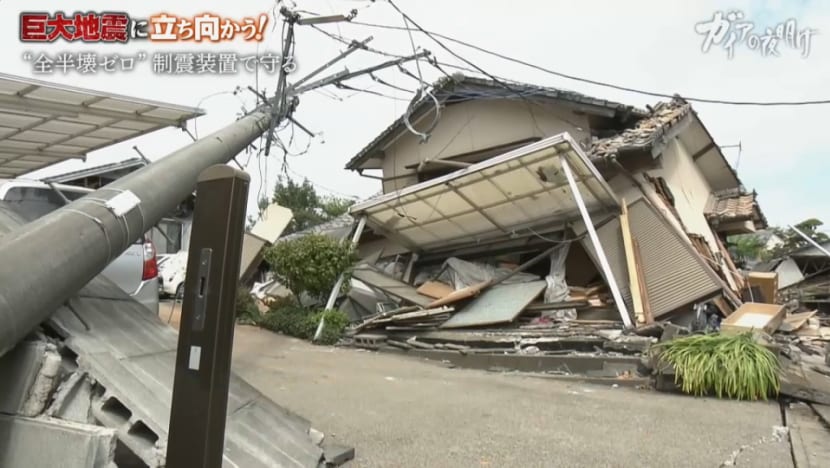Gaia Series 82: Fight Against A Huge Earthquake!
This episode explores Japan’s seismic innovations, documenting survivors, engineers and global efforts to protect lives and cultural heritage.


This audio is generated by an AI tool.
This episode takes a powerful look into Japan’s advances in earthquake resilience, from recovering devastated cities to high-tech breakthroughs.
When the ground shook violently on the afternoon of Jan 1, 2024, Japan was once again reminded of its precarious existence on the earthquake archipelago. The magnitude-7 earthquake that struck the Noto Peninsula in Ishikawa Prefecture claimed 489 lives, of which 261 were directly caused by the disaster. Over 150,000 houses were damaged, leaving behind a stark image of collapsed buildings and communities in grief.
In Wajima City, a memorial service was held amid the ruins. Among the bereaved is Ms Yukiko Kobayashi, who lost her father. “He always watched over us with a gentle smile,” she says tearfully. Her pain is compounded by the sight of her family home, now reduced to rubble. Her story is a sombre anchor in this week’s episode, which takes viewers from tragedy to technological tenacity.
The episode traces the story of Mr Tatsuji Matsumoto, 58, from Sumitomo Rubber Industries, who arrives in Suzu City to investigate the extent of the damage. In the town of Shoin, where only two out of 30 houses remain liveable, one survivor, Ms Hiyoko Hasuike, finds her home miraculously intact. “When I arrived, I was surprised to find that our house was still standing,” she says. Built five years ago, her house had been equipped with a seismic damper, an innovation that is the focus of the episode.
Developed by Sumitomo Rubber, the seismic damper uses high-damping rubber to absorb and reduce the energy of tremors. According to Japan’s Cabinet Office, 517 homes in the Noto region had these dampers installed, and none experienced total collapse. It’s a striking statistic that illustrates the potential of these devices to mitigate damage in a country constantly bracing for the next disaster.
The origins of this technology date back to the Great Hanshin-Awaji Earthquake on Jan 17, 1995, which killed 6,434 people and damaged around 640,000 buildings. At the time, Mr Matsumoto was away at university, but the destruction he witnessed when he returned to Kobe left a deep impression. “There used to be a large chimney in this area. It had broken halfway down. That was the biggest shock,” he recalls. The company lost two workers and 17 of their family members. Feeling helpless, Sumitomo resolved to act.
The seismic damper, costing around ¥300,000 (S$2,700) for a new detached home, converts kinetic energy into thermal energy through rubber deformation, a principle akin to warming hands through friction. In Kumamoto, during the 2016 twin earthquakes that damaged nearly 200,000 homes, none of the 119 houses equipped with Sumitomo’s dampers suffered severe damage. This led to their adoption in protecting heritage sites like Kumamoto Castle.
Now, Sumitomo’s expertise is being applied to even older structures. At Tokugyouji Temple in Tatsuno City, built around 1570, Mr Matsumoto is leading a seismic retrofit project. A seismic inspection revealed the temple could collapse in an earthquake, especially since its roof, as with most old temples, is heavier compared to its bottom. “I was shocked to hear that it could collapse even in a magnitude-5 earthquake,” says the priest, Mr Atsuki Naba. The project will involve installing 114 dampers in 30 locations under the floor, all while preserving the temple’s historical appearance.
Unexpected obstacles arise when workers discover concrete and additional support columns under the floor, not included in the temple’s original plans; the temple has continually been restored through the years by different builders. Yet the team adapts, preserving original materials and creatively reinforcing where possible. A promise made two years prior to the now-retired chief priest, Mr Masafumi Nawa, drives their determination. “We must endure and preserve what our ancestors left behind,” he says softly. “It’s important to keep it going.”
The technology’s impact is also global. Mr Matsumoto travels to Taiwan, where its seismic dampers have been installed in over 100 high-rise buildings, including hospitals and apartments. A tragic earthquake in 1999 had killed 2,494 people and damaged over 100,000 homes, spurring the adoption of Japanese seismic technologies. In Hualien, where a 6.0 quake struck in April 2024, a 70-year-old hospital with 144 dampers continued operating despite the tremors. “A hospital is a place to treat patients. It should be a safe and structurally sound building,” says Chief Nurse Ke Qiongfei. “There would have been nothing left to protect lives.”
The episode closes with a scene at Kyoto University’s Disaster Prevention Research Institute, where an experiment tests if the walls of a house equipped with dampers can be made seven times stronger than traditional mud walls. The house withstands seven seismic cycles equivalent to the Noto quake, but fails on the eighth, as energy transfers to the second floor. “The experiment failed,” admits Mr Matsumoto. “But we’ll use this experience for future developments.”
As Japan braces for looming threats like the Nankai Megathrust and a major Tokyo earthquake, this episode serves as both a warning and a call to action. The nation may not know when or where the next quake will strike, but its people and technology remain resolute. As Mr Matsumoto affirms: “We want to contribute to society with a unique technology that only we can provide. Our division is small, but we’ll keep fighting in our own way.”












